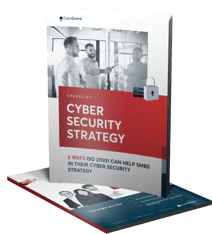Cyber security risk assessment is a process that helps organisations identify and mitigate cyber threats. It's important that you assess your own organisation's risks and make sure they are minimised. This can be challenging, especially if you are a small business owner or an IT manager with limited resources.
In this article, learn about what it takes to run a cyber security risk assessment, the process of conducting one, and how organisations like yours can benefit from it.
In this blog post, we'll cover:
- What is a cyber risk, and how does it relate to cybersecurity risk assessment?
- Why perform a cybersecurity risk assessment?
- Who should perform a cybersecurity risk assessment?
- How do you perform a cybersecurity risk assessment?
- Why do organisations need incident response planning?
- What are the incident reporting requirements under the UK GDPR and NIS Directive?
- What are the frameworks that outline and require incident response measures?
- Why ISO 27001 certification can help with cybersecurity
- What are the two types of risk management techniques?
- How DataGuard can help you run a cybersecurity risk assessment
What is a cyber risk, and how does it relate to cybersecurity risk assessment?
A cyber risk arises when threats compromise or misuse information systems in ways that harm your organisation. It is the threat of hackers accessing sensitive data, stealing intellectual property, and disrupting operations.
Once you are able to understand what cyber risk is and what it entails, risk assessments are what you should be looking at next in your journey to data protection compliance.
A cybersecurity risk assessment can help you understand and identify the following:
- How your organisation's IT infrastructure has been compromised over time, allowing you to better identify vulnerabilities that may have been missed
- How different types of vulnerabilities can affect your organisation's ability to be prepared for a cyber attack
- Different kinds of potential threats to the security of your network and computer systems
- How to identify any threats against your organisation's systems, networks, or assets (such as intellectual property)
- How to determine how well you are protecting your data from unauthorised access and use, including via external parties such as hackers
- How to assess your organisation's ability to respond to an incident if one occurs
- How to determine if your organisation needs to invest in more advanced security measures like firewalls, antivirus software and data encryption tools
Why perform a cyber security risk assessment?
A cyber security risk assessment can help you identify and assess the risks that your organisation faces from hackers. These risks are likely to pose a serious threat to your organisation.
It is important to have an idea of what these risks are and how much you can afford to spend on them. Below are a few other reasons you would want to perform a cyber security risk assessment:
- Reduction of long-term costs
- Provides a cybersecurity risk assessment template for future assessments
- Better organisational knowledge
- Avoid data breaches
- Avoid regulatory issues
- Avoid application downtime
- Data loss
A cyber security risk assessment first looks at the types of attacks your organisation is most vulnerable to, then determines what steps you need to take to protect yourself from these attacks. This information helps you make informed decisions about how best to protect your organisation without spending too much money or time on unnecessary measures.

External Content: YouTube Video
In order to be able to play the desired video, you agree that a connection to the servers of YouTube, LLC, 901 Cherry Ave, San Bruno, CA 94066, USA is established. This transmits personal data (device and browser information (in particular the IP address and operating system) to the operator of the portal for usage analysis.
You can find more information about the handling of your personal data in our privacy policy.
Who should perform a cyber security risk assessment?
Cybersecurity risk assessments should be conducted by a team of experienced professionals with a deep understanding of your organization's IT infrastructure, business processes, and regulatory compliance requirements.
It is best for organisations to have in-house risk assessment teams. This team may include internal staff, such as C-suite executives, IT security professionals, and business unit leaders, as well as external consultants.
For small organizations, it may not be feasible to assemble a dedicated cybersecurity risk assessment team in-house. In these cases, it may be advisable to engage a third-party cybersecurity firm to assist with the assessment.
Regardless of who performs the assessment, it is important to ensure that the team has the following qualifications:
- Expertise in cybersecurity: The team should have a deep understanding of the latest cybersecurity threats and vulnerabilities, as well as the best practices for mitigating them.
- Industry knowledge: The team should have experience conducting cybersecurity risk assessments for organizations in your industry. This will help them to identify the specific risks that are most relevant to your business.
- Communication skills: The team should be able to communicate the findings of the assessment to stakeholders in a clear and concise manner.
How do you perform a cyber security risk assessment?
A cyber risk assessment is a process that you can use to identify any potential risks that might be associated with your organisation's digital network. You may want to perform this process regularly, or at least once a year, to make sure that your network is operating as safely and securely as possible.
Step 1: Determine the information value
Information value is the most important step in performing a cyber risk assessment. To make sure that you have the right information, you must first determine what information is valuable to your organisation and how much it would cost to obtain it.
You can do this by asking questions like: "Is our data currently stored in a central location?" or "How much money have we spent on security breaches over the past year?"
Once you have determined the value of each piece of data, it's time to assess its worth. You can then use this information to create an overall picture of your company's cyber security status.
To ensure that everyone involved is aware of how the risk is communicated, they should all be familiar with terms that are used in risk assessments. Consider frameworks and standards like ISO 27001 in order to correctly set up a risk assessment of information security hazards.
Step 2: Identify and prioritise assets
You are now halfway through your cyber risk assessment process. The next step is to identify and prioritise the assets that need to be protected.
As you did with business processes, think about how important each asset is to your organisation. For example, if your company sells products online, what's your most valuable asset? Is it your customer relationship management software? Is it your website itself? Is it the brand name and reputation of your company?
Once you've identified the essential assets, prioritise them by value. For example, if you have customer data that could be stolen through a hack into your CRM system, make sure to protect that data first rather than paying someone else to do so for you. To protect this data, for example, you'd need to block off access from unauthorised users and monitor who has access so that no one can use it inappropriately.
You must work with management and business users to assemble a list of all important resources. If appropriate, gather the following information for each item:
- Software
- Hardware
- Data
- Interface
- End-users
- Support personal
- Purpose
- Criticality
- Functional requirements
- IT security policies
- IT security architecture
- Network topology
- Information storage protection
- Information flow
- Technical security controls
- Physical security controls
- Environmental security
Step 3: Identify cyber threats
The third step in performing a cyber risk assessment is to identify potential cyber threats. During this step, you need to assess the security posture of your organisation and identify any gaps that need to be addressed.
You'll also want to consider whether your organisation's existing security measures are effective and if they need to be changed.
To do this, you'll need to understand what constitutes a cyber threat and how these threats can be categorised. In order for your organisation's cyber defences to be effective, you'll need to know what types of attacks are most likely and how they can be prevented or mitigated.
There are other hazards, in addition to the obvious ones like hackers, malware, and other IT security risks such as:
- Natural disasters
- System failure
- Human error
- Adversarial threats
By identifying potential cyber threats, you'll also be able to prioritise which ones should be addressed first. This ensures that the most critical security issues are addressed as quickly as possible while still allowing time for more minor issues (such as outdated equipment) before they become problematic.
Step 4: Identify vulnerabilities
Now that we have identified the vulnerabilities in our network, let’s figure out which ones pose the greatest threat to the company and its customers.
The first step is to use a vulnerability scanner to find any security gaps and weaknesses. Vulnerabilities are found through vulnerability analysis, audit reports, the National Institute for Standards and Technology (NIST) vulnerability database, vendor data, incident response teams, and software security analysis.
Once we have identified our vulnerabilities, we need to prioritise them based on their potential impact and likelihood of occurrence. This process is known as risk assessment, and it helps us determine what should be done to mitigate the risk of an attack occurring against our system.
Step 5: Analyse controls and implement new controls
Once you have determined the risks to your business, you can start implementing controls to reduce those risks. The best way to do this is with a cyber risk assessment. This step helps you identify the controls that are most likely to reduce those risks and then implement them.
To perform this step, start by asking yourself:
- What kinds of risks does my business face?
- What kinds of controls does it need to reduce those risks?
- How do I know if my control is working?
Once you've answered these questions, you'll be able to identify what controls to implement to reduce your company's cyber risk.
Hardware, software, encryption, intrusion detection systems, two-factor authentication, automated updates, and continuous data leak detection are all examples of technical controls. Security regulations and physical access techniques like locks and keycards are examples of non-technical controls.
Step 6: Calculate the likelihood and impact of various scenarios on a per-year basis
After performing an initial risk assessment, you want to calculate the likelihood and impact of various scenarios on a per-year basis. This helps you determine how your organisation can best prepare for and respond to a cyber attack.
To calculate the likelihood and impact of various scenarios on a per-year basis:
Step 1: Calculate the annualised rate of occurrence by dividing each scenario's occurrence rate by its maximum occurrence rate. For example, if you know that your organisation has experienced a 50% chance of experiencing a data breach in the past year, then divide 50% by 100%, which equals 0.5 (50/100). This tells you that there's only a 50% chance that they'll experience another data breach in the coming year.
Step 2: Conduct a similar calculation for all other scenarios you're considering. Once all calculations are complete, compare them against each other to determine which scenario has the greatest impact on your organisation, and take steps accordingly.
Step 7: Prioritise risks based on the cost of prevention vs information value
In this step, you can now prioritise the risks based on their cost-to-prevention ratio. The cost of prevention is the cost of preventing a cyber attack, while the value of information lost is the value of the information that would be lost if your company were attacked.
To determine these costs, you need to know:
Step 1: What resources are available to you? If your company has a limited budget and no contingency plan in place, then increasing security might not be able to be afforded until you can add more resources. If this is the case, then prioritising security efforts according to their potential impact on your bottom line will make sense.
Step 2: What type of information does your business hold? If it’s valuable customer data or intellectual property, then it should be given a higher priority than other types of information.
Step 3: How much time do you have? You may have limited resources available for each risk and, therefore, need to prioritise them accordingly.
Step 8: Document results from risk assessment reports
It's important to document the results of your assessment so that you can use them later to help make informed decisions about security.
In this step, we'll cover how to document your risk assessment reports.
Step 1: Create an Excel Template for Reporting Results
To begin, create an Excel template for reporting results. This will allow you to easily track and organise your findings as they come in while making it easy to add comments and notes at any time in the future.
Step 2: Add Information About Each Assessment Report
Add information about each report that you create, including any conclusions or recommendations made by the assessment team. This will allow you to easily refer back to the report at any point in time and see what they've found out about your company's security posture.
The UK GDPR (General Data Protection Regulation) and the NIS Regulations (The Network and Information Systems Regulations) have established harsh measures that can make or break an organisation's response to a cyber security incident.
Controlling your risks, costs, and exposure all depend on how quickly you can recognize and minimise such situations. It is possible to save your organisation millions of pounds by doing an effective assessment of its cyber risk.
Why do organisations need incident response planning?
Incident response planning is a critical component of data protection in any organisation, but it is especially important for organisations that are larger and more complex. The simple reason for this is that incidents can quickly become disasters if they are not handled correctly.
You are also able to set up systems that allow you to monitor all activities within your network, including email traffic and social media posts and respond automatically if anything suspicious happens.
What are the incident reporting requirements under the UK GDPR and NIS Directive?
As an organisation, you have an obligation to report any data breaches to the appropriate authorities. If you think that your data has been stolen or compromised, it is important that you take steps to protect yourself and your organisation.
If you are an organisation with fewer than 250 employees, the UK GDPR only applies to personal data that is processed by you. If you are an organisation with more than 250 employees, you must comply with both the UK GDPR and the NIS Directive (or a similar set of laws).
Under the UK GDPR, organisations are required to notify relevant individuals about data breaches within 72 hours of becoming aware of them. If possible, they must also notify regulators and law enforcement agencies as soon as possible.
Under the NIS Directive, organisations must notify regulators if they suspect they have experienced a security incident that could put their customers at risk.
What are the frameworks that outline and require incident response measures?
Incident response frameworks help outline your organisation's overall incident response plan, as well as the measures you will put in place to respond to incidents.
Incident response is required under the following standards:
- ISO 27001 (information security management system) - The international standard for an Information Security Management System (ISMS).
- ISO 22301 (business continuity management system) - The international BCMS standard.
- The PCI Data Security Standard (PCI DSS) (Payment Card Industry Data Security Standard)
Under the rules of the Cabinet Office's security policy framework, UK government agencies must also report cyber events, thereby requiring a Cyber Incident Response for such organisations.
Why ISO 27001 certification can help with cybersecurity
ISO 27001 certification is an internationally recognised standard for Information Security Management Systems (ISMS). It provides a framework for organisations to implement a comprehensive cybersecurity programme that protects their information assets and reduces the risk of cyber-attacks.
The ISO 27001 standard requires organisations to have a documented incident response plan and to test and update this plan regularly. This helps organisations to ensure that they are prepared to respond quickly and effectively to any incidents and to minimise the impact of those on their business.
In addition, ISO 27001 includes a number of other requirements that can help improve incident response capabilities. For example, the standard requires organisations to
- Identify and assess their cyber security risks.
- Implement controls to mitigate these risks.
- Monitor their networks and systems for suspicious activity.
- Detect and respond promptly to cyber incidents.
By implementing the ISO 27001 standard, organisations can significantly reduce their risk of cyber-attacks.
If your organisation is serious about improving its cybersecurity posture and complying with relevant regulations, obtaining ISO 27001 certification is an essential step.
What are the two types of risk management techniques?
Risk management is the process of evaluating and understanding risks, as well as determining how to manage them. It can also be defined as the method of predicting the occurrence of undesirable events in an organisation.
Risk management techniques can be divided into three categories:
|
Component-driven risk management techniques |
System-driven risk management techniques |
Integrated risk management techniques |
|
These techniques focus on identifying and managing risks by applying a specific approach to each component of a system |
These techniques focus on identifying and managing risks by analysing an entire system or organisation as a whole |
This combines both component-driven and system-driven approaches by using both approaches at once
|
These techniques are different from the traditional techniques of risk assessment, which is a process used to determine the likelihood of risk occurring.
How DataGuard can help you run a cybersecurity risk assessment
DataGuard helps organisations like yours safeguard their data and maintain a strong cybersecurity posture. We are committed to staying up-to-date with the latest cybersecurity best practices and offer a range of services that can assist businesses in running a cybersecurity risk assessment and developing a robust ISMS.
We understand that as your organisation grows, your information becomes more complex and valuable, making it more susceptible to theft or loss. By implementing the right processes and obtaining ISO 27001 certification, you can significantly reduce the likelihood and impact of future risks. Find out how we can help you.


5 Ways ISO 27001 Can Help SMBs in Their Cybersecurity Strategy
Download your free e-book today and learn how to protect your business from cyberattacks with ISO 27001 certification!
Download E-book









